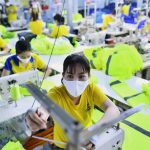The chairman of the Vietnam Garment and Textile Association, Vu Duc Giang, has said that Vietnam’s apparel exports are expected to bring in US$42 billion by the end of 2022, below the year’s target of US$43-44 billion.
In October, apparel exports generated US$3.18 billion, down 3.3% year-on-year and 1% from 2019. Among exports, yarn exports fell 34% compared to 2021, valued at US$307 million, while textile exports only increased by 1.7% to US$2.87 billion.
At the same time, apparel exports to major markets fell year-over-year. Exports to the U.S. fell by 14% in value, earning US$1 billion, those to South Korea slid by 9%, earning US$380 million, and those to China dropped by 35%, earning US$230 million.
Giang attributed the decline in garment export value in October to global economic uncertainties, such as the rise of the U.S. dollar, rising interest rates and dampened demand.
Yet the garment export value, as of October, increased by 17.2% year-on-year with 47 to 50 categories of products exported to 66 different countries and territories, valued at US$37.9 billion.
Clothing garments account for a large proportion of the sector’s total export value, bringing in about US$29.1 billion. The U.S. is the largest importer of garments from Vietnam, garnering US$13.9 billion in exports.
Besides textiles and garments, Vietnam exported fabrics, yarns, and sewing materials, bringing in US$2.13 billion, US$4.08 billion, and about US$1.17 billion, respectively.
Agriculture sector aims to increase use of organic fertilisers
The Ministry of Agriculture and Rural Development (MARD) aims to have local production using 25% organic fertilisers in the next three years.
MARD also planned to increase the amount of qualified production by 1.25 times, equivalent to 5 million tonnes per year.
MARD said it would develop the production and use of organic products, while maintaining efficiency and sustainability, and contributing to promoting added value and protecting the environment.
The industry is developing a model for the use of organic fertilisers, using economical, balanced and effective fertilisers in nine key national crop groups.
In the action plan to increase production and use of organic fertilisers, and to use fertilisers economically, in a balanced and efficient manner for the 2022 – 2025 period, MARD will review a new system of standards and regulations.
It will support the registration and recognition of organic fertilisers that do not have to be tested in accordance with the law to develop a rich and diverse set of products in terms of quantity and type. New organic fertiliser products will also be researched and developed through the selection of input materials and appropriate production technology.
It will encourage the development and use of self-produced organic fertilisers on an industrial and household scale, taking advantage of abundant and available by-products in cultivation, husbandry and aquaculture, agricultural product processing, and domestic waste.
Vietnam must specify target markets for organic farm produce
Vietnam needs to specify target markets and control the implementation of standards in organic agricultural production to meet the needs of the domestic and foreign markets.
At a forum on the development of organic farm produce held by the Ministry of Agriculture and Rural Development (MARD) on November 21 in Ho Chi Minh City, Deputy Minister of Agriculture and Rural Development Tran Thanh Nam said that organic agricultural production must be associated with the development of the consumption market.
Organic products with specific characteristics must comply with strict standards and often have low yields and high costs. These products are for the high-end market segment.
According to Nam, organic agriculture development must be the right way to approach potential customers at home and abroad.
Along with reasonable planning, standards and management for the production and certification of organic agricultural products must be strictly implemented to improve the quality of Vietnam’s certified organic products.
Vietnamese organic farming products are exported to about 180 countries and territories, with an export turnover of 335 million USD per year. The exported organic farming products are tea, shrimp, rice, cashew nuts, pepper, cinnamon, anise, essential oils, and spices.
The main export markets of those products include France, Denmark, Switzerland, Sweden, China, Cambodia, the US, Italy, Germany, the UK, Russia, Canada, Belgium, Thailand, Malaysia, Netherlands, Hong Kong (China) and Taiwan (China).
HCM City to host S.E.A Connect
S.E.A Connect, a trade fair dedicated to facilitating market access for international F&B and Retail brands entering Southeast Asia, will be held in Ho Chi Minh City on November 25.
Organised by Simple Group from Singapore, the fair aims to provide a platform for entrepreneurs and potential franchisees in Vietnam to network and connect with over 30 brands in the F&B and Retail sectors, which have had proven and successful business concepts in the Asia Pacific region.
A panel on the F&B sector will address the current situation and key driving factors, as well as explore the latest trends of Vietnam’s F&B market, while another discussing various topics to understand modern trade insights and local consumers’ behaviours, and support international retailers navigate emerging markets like Vietnam will be held on the sidelines of the event.
Vietnam advised to produce green, clean goods to win over European consumers
Vietnamese companies must understand trends in the EU consumer market, which is undergoing a significant shift towards green and clean goods that meet international labour and environmental standards, the European Chamber of Commerce in Vietnam (EuroCham) has said.
At a seminar on exporting to the market held in Ho Chi Minh City last week, EuroCham Vice President Jean-Jacques Bouflet said the EU market is interested in the production processes. “So enterprises must anticipate this trend to accelerate the effective implementation of the EU-Vietnam Free Trade Agreement (EVFTA).”
According to EuroCham, the EU has a set of policies and actions called the European Green Agreement, whose goal is that its economy will be more sustainable and carbon neutral. The action plan also seeks to reduce pesticide use by 50% and increase the share of lands under organic crops to 25% by 2030.
He warned that the EU constantly tinkers with regulations, and exporters need to remain on top of the changes.
To enjoy preferential tariffs, Vietnamese goods exported to the EU must meet two basic conditions: comply with the required market sanitary and phytosanitary standards and meet the rules of origin.
EuroCham also warned there is a gap between Vietnamese and international standards, pointing out that for instance Vietnam applies VietGap standards but global consumers prefer Global Gap, BAP and other international standards.
Access to the EU market would open doors to other markets, but it requires business leadership and Government support, he said.
Ministry proposes schemes for fuel environmental tax next year
The Ministry of Finance has put forward several environmental tax proposals on fuel and lubricant in 2023.
In the first scenario, in which global oil prices dip under 70 USD per barrel, environmental tax is set at a ceiling of 4,000 VND per litre of gasoline, 3,000 VND per litre of jet fuel and 2,000 VND per litre of diesel. In this scenario, state budget collection is said to be unaffected.
In the second scenario, in which global oil prices stay between 70-80 USD per barrel, environmental tax is set to decrease by 25% from the ceiling limit or 3,000 VND per litre of gasoline, 2,250 VND per litre of jet fuel and 1,500 VND per litre of diesel. Consequently, state budget collection is said to decrease by 1.4 trillion VND per month.
In the third, in which global oil prices stay between 80-100 USD per barrel, environmental tax is to be cut by half or 2,000 VND per litre of gasoline, 1,500 VND per litre of jet fuel and 1,000 VND per litre of diesel. State budget collection is said to decrease by 2.8 trillion VND per month.
Lastly, in which global oil prices reach over 100 USD per barrel, environmental tax is to be set at a floor limit of 1,000 VND per litre of gasoline, 1,000 VND per litre of jet fuel and 500 VND per litre of diesel. In this scenario, state budget collection is said to decrease by 4.2 trillion VND per month.
Ministry continues to consider adjusting costs of petrol
The Ministry of Finance (MoF) is taking steps to stabilise domestic gasoline prices and supply while removing difficulties for petroleum traders, said Nguyen Tien Minh, Director of the MoF’s Price Management Department.
The Fuel Price Stabilisation Fund has been used consistently for the purpose of stabilising petrol prices in line with the law, according to the department. The fund has been effectively used to stabilise petrol prices to help curb inflation and stabilise the macro economy.
Petroleum is an essential commodity, and it has a strong impact on production, business activity and people’s lives. High gasoline prices and the shortage of petroleum supply put great pressure on the business costs of enterprises as well as people’s spending. Vietnam must also contend with global fluctuations in fuel prices, which affect domestic gasoline prices and create unpredictable developments.
From April 1, 2022 to the end of December 31, 2022, there will be a 50% cut in the environmental protection tax on gasoline (excluding ethanol), diesel fuel, mazut, lubricants and grease and a 70% cut in the environmental protection tax on kerosene.
The Government has also halved the most-favored-nation (MFN) import tariff on unleaded gasoline to 10% from 20%.
Vietnam, US begin new initiative to promote private sector-driven sustainable growth
Vietnam’s Ministry of Planning and Investment (MPI) and the US Mission to Vietnam, through the US Agency for International Development (USAID), on November 22 announced a new initiative to spur private sector-driven sustainable and inclusive growth across Vietnam.
The new initiative promotes socially-conscious business behaviour, known as Environmental, Social, and Governance (ESG) standards.
Investors use ESG standards to measure how a company protects the environment; manages its relationships with workers, customers, and the communities where it operates; and employs transparent and accountable corporate governance.
USAID Assistant Administrator for Asia Michael Schiffer and Vice Minister of Planning and Investment Tran Quoc Phuong announced the ESG initiative at a USAID-supported business forum.
This first-ever ESG initiative for Vietnam targets small and growing businesses (SGBs). SGBs account for more than 90% of Vietnam’s private sector, employ more than 50% of the workforce, and contribute roughly 40% of GDP.
As such, SGBs play a critical role in Vietnam’s socio-economic development and environmental sustainability. ESG is a recognition that business sustainability is multi-faceted, extending beyond environmental issues to people, resources, and systems. Businesses that invest in more energy efficient technology, create a good impact on communities, and consider input and feedback from people affected by the business achieve consistent growth and have stronger business models.
Vietnam’s exports to EU grow 23.5% in ten months
The trade turnover between Vietnam and the European Union (EU) reached 52.5 billion USD in the first ten months of this year, up 14% over the same period last year, according to the Ministry of Industry and Trade (MoIT).
Of which, exports hit 39.7 billion USD, a year-on-year increase of 23.5%, it said.
The EU is currently Vietnam’s leading trade partner and third largest export market with an annual export growth rate of 7.5%, accounting for 13.6% of the Southeast Asian country’s total export turnover in 2015-2021 period.
The market share of Vietnamese goods in the EU’ total imports is 1.8%, higher than that of other Southeast Asian countries such as Malaysia (1.2%), Thailand (0.9%), Indonesia (0.7%) and Singapore (0.7%).
Vietnamese businesses seeking to further penetrate South Africa
The Ministry of Industry and Trade (MoIT) recently sent a delegation of 20 Vietnamese businesses to South Africa to scope out the market.
The country is now Vietnam’s biggest trade partner in Africa with annual two-way trade exceeding 1.2 billion USD between 2019 and 2021, according to Pham Thanh Hai, First Secretary at the Vietnam Trade Office in South Africa.
It mainly imports aquatic products from Vietnam, and the demand is expected to grow in the time ahead, the official said, noting that supermarkets there serve not only local residents but also those from neighbouring countries of South Africa.
However, due to the long geographical distance, many Vietnamese enterprises have yet to pay attention to the market. Besides, they have also faced limited access to market information.
Given this, the Vietnam Trade Promotion Agency (VIETRADE) has organised many consulting sessions on the Middle East and Africa, providing information about the market, import-export rules and other issues for domestic firms.
Vietnam launches e-commerce app for mechanical industry
An e-commerce app for Vietnam’s mechanical industry has been officially launched with the expectation of bringing digital transformation closer to people’s lives.
Named “mechanical supermarket”, it is a place where all mechanical items and accessories are sold. Consumers can see prices and purchase them remotely.
According to Nguyen Nhut Minh Tri, a representative of the app development team, people working in the mechanical industry in Vietnam often face difficulties in searching for accessories, which are rarely available on consumer e-commerce platforms. That is the reason why this app was initiated, he said, saying it is also the first e-commerce platform for the mechanical industry in Vietnam.
The development of the app aims to accelerate the digital transformation in the mechanical industry in Vietnam, Tri noted, pointing out the potential for the expansion of the model in the future.
39 foreign suppliers register tax in Vietnam
A total of 39 foreign suppliers have registered tax in Vietnam via the portal https://etaxvn.gdt.gov.vn/nccnn/Reques, according to the Tax Agency for Large Businesses at the General Department of Taxation.
Among them are Meta (Facebook), Google, Microsoft, TikTok, Netflix, and Apple that account for up to 90% of the market share in the field of cross-border e-commerce.
Other names in the list include iHerb, LLC; Netflix Pte. Ltd; Tiktok Pte. Ltd; Blizzard Entertainment Inc; Educational Testing Service; Ezviz International Limited; and LinkedIn Singapore Tte. Ltd, among others.
Some 22.2 million USD has been collected via the portal which was exclusively developed for foreign suppliers and put in place on March 21.
The tax agency will step up the communication work in the time ahead to further facilitate tax registration, declaration and payment in Vietnam in line with the country’s commitments and regulations on added value and corporate income taxes for cross-border services.
Agricultural sector aims to increase use of organic fertiliser
The Ministry of Agriculture and Rural Development (MARD) aims to have local production using 25 per cent organic fertilisers in the next three years.
MARD also planned to increase the amount of qualified production by 1.25 times, equivalent to 5 million tonnes per year.
MARD said it would develop the production and use of organic products, while maintaining efficiency and sustainability, and contributing to promoting added value and protecting the environment.
The industry is developing a model for the use of organic fertilisers, using economical, balanced and effective fertilisers in nine key national crop groups.
In the action plan to increase production and use of organic fertilisers, and to use fertilisers economically, in a balanced and efficient manner for the 2022 – 2025 period, MARD will review a new system of standards and regulations.
It will support the registration and recognition of organic fertilisers that do not have to be tested in accordance with the law to develop a rich and diverse set of products in terms of quantity and type. New organic fertiliser products will also be researched and developed through the selection of input materials and appropriate production technology.
It will encourage the development and use of self-produced organic fertilisers on an industrial and household scale, taking advantage of abundant and available by-products in cultivation, husbandry and aquaculture, agricultural product processing, and domestic waste.
Households in a better financial position, but external risks remain
Viet Nam’s economy has rebounded strongly from the last quarter of 2021 with retail spending growth of 15 per cent annually, indicating that households are in a better financial position, Ramla Khalidi, Resident Representative of UNDP in Viet Nam spoke at the Vietnam Economic Pulse Forum on November 22.
The representative said risks to economic recovery were exclusively external. The Russia-Ukraine conflict, the economic slowdown in China, the rising of international interest rates, the strengthening of the dollar and the growing risk of recession in Europe would affect demand for Vietnamese exports and increase the risk of macroeconomic instability.
Francois Painchaud, IMF Resident Representative for Viet Nam and Laos, said tentative signs of slowdown and inflation in Viet Nam had been picking up recently. The Vietnamese dong was coming under depreciation pressure and interest rates are increasing.
The representative said IMF had revised Viet Nam’s growth in 2022 to around 7.0 and 7.5 per cent, making Viet Nam one of the best-performing countries in the region.
However, given the slowdown in external demand and tightening global financial conditions, the country was forecast to reach a lower growth rate of 5.8 per cent in 2023. Inflation was projected to edge up before gradually returning to 4.0 per cent in the short term.
Tran Toan Thang, Director of Industry and Enterprise Economic Forecasting Department, National Centre for Socio-economic Information and Forecast, said Viet Nam’s economic growth would hit roughly 8 per cent in Q4, fueled by manufacturing and service sectors.
Nguyen Quang Thuan, CEO of FinnGroup, underlined five key risks to the economy, which are social unrest, bond defaults, corporate debt liquidity crunch, foreign capital flight, and growth target undershooting. He said the second risk was high, caused by the overrepresentation of private bondholders in the bond market, weak financial transparency and bond miss-selling by intermediary institutions.
Jonathan Pincus, UNDP Senior International Economist, said Viet Nam was a strong performer in terms of both economic growth and exports. As economic growth and exports were closely related, the latter should be top of mind for the country.
Securities companies adjust business results amid market downturn
KS Securities Company has just announced adjustments to its business plan. The targeted revenue in 2022 decreased by 56.3 per cent compared to the initial plan, from VND2.04 trillion to VND890 billion. Target profit also declined by nearly 37 per cent to VND450 billion.
In the first 9 months of 2022, this company earned VND719 billion in revenue, 3.49 times higher than the same period last year; profit after tax reached VND430 billion, also 3.8 times higher than the same period last year.
The results achieved still fell short of the targets set out at the beginning of the year. Explaining to shareholders, the company’s leaders said that the market had witnessed great fluctuations since April 2022. The company’s business strategy had changed in the direction of technology development. These two factors had a strong impact on the business plan of KS Securities.
VNDirect Securities Co’s pre-tax profit target is set at VND2.99 trillion for the whole of 2022. In the first 9 months of this year, VNDirect reported a profit of VND1.57 trillion, down 19 per cent over the same period last year and also just completed 52 per cent of the profit plan.
SSI Securities Inc also completed only 52 per cent of the profit target set out in the first 9 months of this year. Previously, at the annual general meeting of shareholders in early May 2022, Chairman of the Board of Directors of SSI Nguyen Duc Hung was still quite confident with the target of 30 per cent growth in both revenue and profit.
Except for the rare recovery rate recorded in July-August 2022, Viet Nam’s stock market traded negatively in both scores and liquidity from the second quarter onwards.
APG Securities Co reported a loss of more than VND49 billion in the third quarter of 2022. This dragged the profit of the first 9 months to negative VND48.3 billion, while the initial profit target was set at VND400 billion.
APEC Securities Co (APS) reported a loss of VND370 billion in the first 9 months of this year. The task in the fourth quarter of 2022 is not feasible as the company wants to earn profit of VND480 billion.
VietinBank Securities (CTS) also earned a profit of VND86 billion in 9 months, equivalent to more than 21 per cent of the target set out. BIDV Securities Co (BSC) completed nearly 35 per cent of the 9-month target, although it was profitable in the third quarter.
Some securities companies still beat targets thanks to careful planning. MB Securities Co (MBS)’s 9-month profit has completed 63 per cent of the target set in the negative scenario. Agribank Securities completed 88 per cent of the profit plan thanks to its initial cautious goal, which was behind the results achieved in 2021.
Singapore’s Leader Energy acquires Binh Thuan solar power plant
The Vinh Hao 6 solar power plant was run by Vinh Hao 6 Power JSC, which is held by ACWA Power, FECON Corporation and FECON Power JSC. With a total investment of $53 million, the Vinh Hao 6 solar power plant has achieved its Commercial Operation Date (COD) in June 2019.
The solar power plant has been operated under a power purchase agreement for 20 years, with a fixed selling price of $93.5 per MWH. The project has a designed capacity of 50MW with an expected power output of 83 million kWh/year.
The 50MW Vinh Hao 6 solar power plant was the first renewable energy project of ACWA Power in Vietnam and also the first energy investment project of FECON.
Hunt for fresh land banks taking off across key regions
A series of large real estate projects have been bought up by investors as they move towards assets in second-tier cities, with land availability limited in major urban areas.
This month, Malaysian property developer Gamuda Land announced that it has acquired a local company to develop a high-rise apartment building in Thu Duc city of Ho Chi Minh City.
A few months earlier, Gamuda Land Binh Duong announced that it had acquired a 56,000sq.m land plot in Binh Duong New City from Binh Duong Trade and Development JSC for developing townhouses, with a value of more than $53 million.
Capitaland Development (CLD), a real estate developer from Singapore, announced recent investments including the acquisition of a prime mixed-use site in Thu Duc city, with an estimated gross development value of about $720 million. The mixed-use project over eight hectares will comprise over 1,100 high-end residential units and shophouses to meet the residential demand of Thu Duc’s growing workforce.
Ronald Tay, CEO of CLD Vietnam, said that the company had been exploring opportunities to diversify its asset class involvement beyond the company’s traditional expertise to new classes like township developments, logistics, industrial and business parks, and data centres.
Recent reports from market research consultants show that available land in big cities such as Ho Chi Minh City and Hanoi is increasingly scarce, especially in the central core areas. Many investors have moved to satellite cities or neighbouring provinces, which are considered replacements with potential.
According to BIDV Securities Company’s data, many giant developers are exclusively expanding to satellite areas, such as Vinhomes, Novaland, Hung Thinh, Nam Long, and many others. The provinces of Dong Nai, Binh Duong, and Long An are on the radar for many investors.
Nam Long Corporation has implemented the 355-hectare Waterpoint project in Long An, and Phu Dong Group and Samland are developing projects in Binh Duong.
Nguyen Thi Hong Hue, deputy director of MIK Home, said that apart from the Imperia Grand Plaza in Long An, it was mainly expanding its portfolio to the northern provinces of Vinh Phuc and Bac Ninh.
Hung Thinh Land, another developer, is expanding its portfolio to Quy Nhon with Hai Giang Merryland, Fiveseasons Homes in Vung Tau, and New Galaxy in Nha Trang.
Ngo Quang Phuc, general director of Phu Dong Group, said developers have quickly grasped the trend for new destinations.
According to Phuc, the current M&A outlook in land is no different to hunting because there is much land but it is very difficult to successfully choose a good land plot to fit the developers’ targets.
Meanwhile, Le Hoang Chau, chairman of the HCMC Real Estate Association, said that to achieve success in M&A strategies, the cash source was not the only problem.
Ministry proposes widening expressway on VEC’s budget
The Ministry of Transport has proposed that the prime minister allow the Vietnam Expressway Corporation (VEC) to tap into its own budget to widen a section of the HCMC-Long Thanh-Dau Giay Expressway in southern Vietnam.
In its proposal, the ministry said VEC is the developer and operator of the HCMC–Long Thanh Expressway, which enables it to collect tolls to pay the Asian Development Bank and the Japan International Cooperation Agency. Meanwhile, it will be difficult for the ministry to balance the medium-term public investment capital for the expansion project in 2021-2025.
Thus, allowing VEC to expand the expressway with its funds would bring more benefits, the ministry said.
According to the proposal, VEC is tasked with reporting on pre-feasibility studies, the possibility of achieving a balanced budget, and mechanisms associated with the project’s implementation.
VEC will widen the 21.9-kilometer-long section between HCMC and Dong Nai Province’s Long Thanh. The section connects the interchange with Beltway No.2 in HCMC and the Bien Hoa-Vung Tau Expressway interchange.
Of this, a section from the interchange with Beltway No.2 with the interchange with Beltway No.3 would be expanded to eight lanes, while the remaining section from the interchange with Beltway No.3 to the interchange with the Bien Hoa-Vung Tau Expressway would be widened to 10 lanes.
Germany’s PNE AG to develop offshore wind farm in Binh Dinh
PNE AG, a German company, has signed a memorandum of understanding with Binh Dinh Province to develop an offshore wind farm. The signing took place at an investment promotion conference held in the province on November 21.
With an estimated cost of US$4.6 billion, the offshore wind energy project is expected to have a capacity of 2,000 MW, contributing to the country’s electricity industry and facilitating the socio-economic development of the province.
Thorsten Fastenau of PNE AG said the company would build 154 to 166 wind turbines in three phases once the project is approved. In the first phase, the project will be developed in the seas off Phu Cat and Phu My districts, with a capacity of 700 MW, requiring an investment of US$1.6 billion.
Some 20,000 PouYuen workers take paid leave amid order shortfall
A fall in new orders has forced PouYuen Vietnam, a major footwear manufacturer of Taiwan, to require 20,000 of its employees to take paid leave in rotation for three months, according to the HCMC Labor Confederation.
As explained by the most labor-intensive firm in HCMC, the firm’s major export markets have sharply cut orders and the company has competed fiercely to secure orders for sports shoes as its customers have suggested 50% price cuts, the local media reported.
Despite multiple difficulties in business operations, the company has asked only 20,000 of its 50,000 workers to take rotating paid leave over a period of three months, from December 1 to February 28, 2023. The company has pledged not to lay off its employees as the Lunar New Year holiday, or Tet, is drawing near.
The workers affected will mostly take time off on weekends. Each of them will have 14 days off in total and will be paid VND180,000 per day during the given period.
Statistics from the HCM City Labor Confederation showed that 27 enterprises in the city had fired over 2,850 employees, citing an economic slowdown and their plans to restructure business operations.
Source: https://vietnamnet.vn/en/vietnam-business-news-november-23-2083801.html










